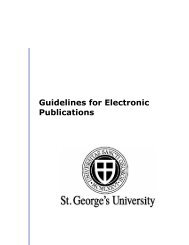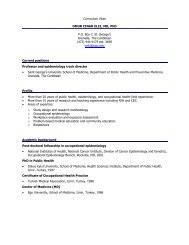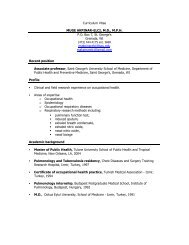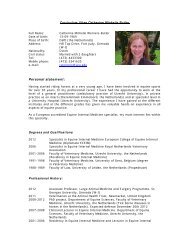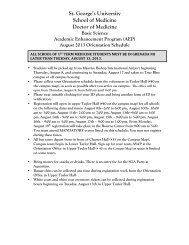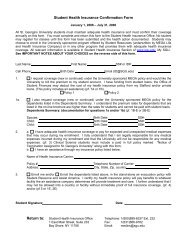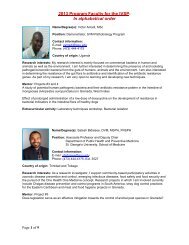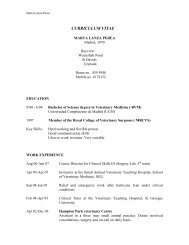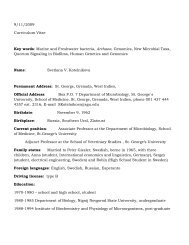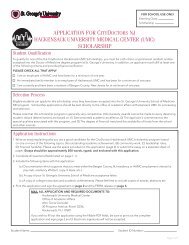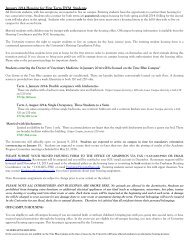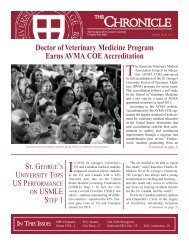SCHOOL OF 2012-2013 - St. George's University
SCHOOL OF 2012-2013 - St. George's University
SCHOOL OF 2012-2013 - St. George's University
Create successful ePaper yourself
Turn your PDF publications into a flip-book with our unique Google optimized e-Paper software.
disorders, such as substance abuse, domestic violence,<br />
and child abuse are discussed with reference to the<br />
physician’s role and responsibility, in terms of detection<br />
and intervention.<br />
An additional theme of the course relates to the importance<br />
of preventive medicine. To develop this concept, students<br />
participate in lectures and group exercises in biostatistics,<br />
epidemiology, and health systems. Within a small group<br />
setting, students apply the tools of biostatistics and<br />
epidemiology to selected public health problems, with<br />
an emphasis on the goal of reading the medical literature<br />
critically. How behavior, environment, and politics influence<br />
health in different societies is also considered—an<br />
international comparison of the health systems of several<br />
countries is provided and factors underlying existing<br />
disparities in health care are explored. Current issues of<br />
health care financing and delivery are discussed, along<br />
with the important changes in insurance systems, cost<br />
containment, and different types of medical practice.<br />
Finally, the fundamental concepts of law that relate to the<br />
medical profession are covered in this course. The concerns<br />
of society in the legislative, judicial, and administrative<br />
regulation of medical practice are emphasized. An<br />
overview is provided of the current and probable future<br />
expansion of society’s role in the regulation of medical<br />
practice of medicine. The basic principles of malpractice<br />
are discussed, in addition to topics such as informed<br />
consent, medical ethics, and confidentiality. The course<br />
surveys the history of medical ethics and compares the<br />
major perspectives on such issues as the conflicts between<br />
different types of benefits to patients, the duties of a<br />
physician, patient autonomy, termination of pregnancy,<br />
end-of-life decisions, social ethics, and rationing of<br />
services. This module within the course comprises the third<br />
component of the “Medicine in Society” course series.<br />
This section of the course comprises of part three of the<br />
“Medicine in Society” course series.<br />
Biochemistry and Genetics<br />
Sharmila Upadhya, MBBS, MD, DNB, Chair<br />
BCHM 550<br />
Medical Biochemistry<br />
The Medical Biochemistry course teaches the science of<br />
biochemistry in a clinical and physiological context. The<br />
course is planned to provide students with a working<br />
knowledge of the biochemical basis of disease processes<br />
for understanding the subsequent courses in the medical<br />
curriculum. The course has about 80 didactic lectures and<br />
seven small group sessions. The first half of the course<br />
provides a background for understanding acid-base<br />
relations, structure and function of macromolecules, the<br />
role of enzymes, and introduction to metabolism and<br />
genetics. The mechanisms of biochemical reactions<br />
with attention being given to their roles in disease are<br />
also discussed. In this half of the term, metabolism of<br />
carbohydrates and their clinical correlation is also discussed.<br />
There is emphasis on the key enzymes and regulatory<br />
steps in metabolic pathways, which are important in<br />
understanding metabolism in different physiological and<br />
pathological situations. In the second half of the term,<br />
lipid and nitrogen metabolism are discussed. This half of<br />
the term is dominated by integrative and clinical subjects.<br />
The biochemical roles of the major organ systems and an<br />
overview of the metabolic interplay between organs are<br />
highlighted. Principles of energy balance, as well as the<br />
role of vitamins and minerals in maintaining good health<br />
are introduced. The biochemical aspects of coagulation,<br />
jaundice, porphyrias, diabetes, obesity, inherited diseases<br />
and under-nutrition are presented. An introduction to<br />
genomics and the use of molecular genetics in diagnostic<br />
medicine is also included to ensure that students have<br />
an understanding of the basic concepts and techniques<br />
of molecular biology, to be able to participate in the<br />
genetic-based medicine of the new millennium. Horizontal<br />
integration with Anatomy and Histology is attempted by the<br />
use of integrative case-based lectures. Interactive audience<br />
response clicker systems are used in most of the lectures.<br />
<strong>St</strong>udents will also participate in eight small group<br />
discussions, which are based on a clinical case facilitated<br />
by clinical tutors. The biochemical aspects of the clinical<br />
scenarios are extensively discussed in these sessions.<br />
BCHM 590<br />
Medical Genetics and Genomics<br />
This course reviews basic genetics and its application to<br />
the study of inherited disorders. It begins with a study<br />
of the chromosomes and the disorders that result from<br />
their aberrations. Exploration of Mendelian and polygenic<br />
inheritance follows, illustrated by representatives of the<br />
major heritable disorders of man. There is coverage<br />
of molecular and clinical genetics, including prenatal<br />
School of Medicine<br />
Course Descriptions<br />
School of Medicine Catalog <strong>2013</strong>–2014 | 59



